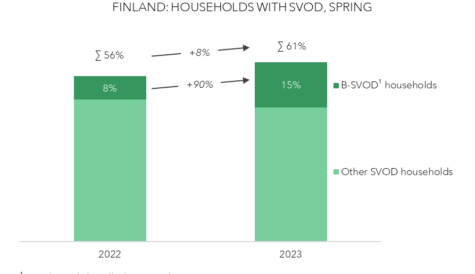
After more than 40 years of operation, DTVE is closing its doors and our website will no longer be updated daily. Thank you for all of your support.
The Year in View
For our final edition of 2022, we’re going expand the scope of DTVE Week in View, which for this week only becomes DTVE Year in View. We’ll take a look at 10 of the most-read stories from 2022 and what they say about the state of the industry.
In reverse order of popularity:
10. Disney becomes world’s largest streaming operator. In August, Disney famously overtook Netflix, reporting half a million more streaming subscribers than its rival in its Q3 results. In truth, Disney offers multiple streaming products to Netflix’s solo brand, but the company’s growth has nevertheless been impressive. Disney+ added 14.4 million customers, while sports streamer ESPN+ saw the biggest proportional increase with 53% growth. All very impressive and a sign of Disney’s brand strength and commitment to streaming. However, not enough to prevent a painful round of cost-cutting, followed by the abrupt departure of CEO Bob Chapek and his replacement by none other than predecessor Bob Iger. Disney’s troubles are shared by multiple big media companies – not least Warner Bros. Discovery – as streaming revenues failed to match increased content costs and losses from cord-cutting.
9. Warner Bros. Discovery halts HBO Max roll out with combined streamer set for launch in France. No story illustrates the challenges being faced by big streaming companies better than the troubles of Warner Bros. Discovery. One manifestation of those troubles was the company’s decision to row back on its streaming ambitions, culling plans for further launches of HBO Max and moving forwards instead with plans for a combined streamer encompassing HBO Max and discovery+, possibly to be called simply Max.
8. Disney, Apple and Amazon all bid for NFL Sunday Ticket rights. The rise of sports streaming and growing competition for sports rights from new entrants has been one of the big stories of the year. The competition for US NFL Sunday Ticket rights in June was emblematic of the changing environment in sports, with previous holder DirecTV, representing declining legacy pay TV, declining to bid again and potentially pay a much higher price.
7. Sky Showtime go for launch as JV streamer gets regulatory approval. Those legacy pay TV operators are not all standing still, of course. Sky’s parent Comcast teamed up with ViacomCBS (now Paramount) last year to launch a streaming JV in European markets outside of Sky’s existing pay TV and OTT footprint, notably in northern and central and eastern Europe. This is not the first time Sky has experimented with OTT outside of its existing territories – it unsuccessfully launched a service in Spain some years ago – but this is the most ambitious effort to date.
6. Fremantle launches ‘American Idol’ FAST channel in UK on Samsung TV Plus. The onward march of Free Advertising-supported Streaming Television (FAST) has of course been one of the major themes of the year. As a way to make money from underused rights, it appeals not only to the big studios but to well-resourced production companies that see the free direct-to-consumer approach as potentially more lucrative than licensing those rights to third parties. Whether the revenues justify the outlay in all cases under consideration remains to be seen but for now FAST is definitely on the rise.
5. AVOD market to reach US$260 billion annual revenue by 2025. Further highlighting the growing importance of advertising to the streaming business, case, this report by our sister research outfit Omdia forecast that advertising-supported video-on-demand streamers will grow extensively over the next three years, driven by the US and China. Hybrid SVOD/AVOD service launches have been much in evidence recently, with Netflix’s Basic with Ads offering going head-to-head with Disney’s ad-supported tier. At a more local level, UK broadcaster ITV has submerged SVOD service Britbox in its new expanded hybrid offering, ITVX, which leans heavily on the free, ad-supported model.
4. Sky to offer standalone streaming option later this year. Just as consumers have progressively moved towards on-demand consumption, particularly at the premium level, pay TV operators have responded by de-emphasising linear and highlighting their own streaming on-demand credentials. For some, including Sky, that means progressively giving up on legacy satellite or broadcast infrastructure and moving towards a streaming-centric model. Interestingly, The Sky Stream puck, which has now launched, was previously available to Sky customers who took its Sky Glass integrated TV as a multiroom option. However, Sky has now made it available to subscribers who do not want to take the Sky Glass option, with the device able to operate independently of the TV.
3. Virgin Media launches all-IP Stream platform. Not to be outdone, Sky UK rival Virgin Media launched its own all-IP platform in April. The device, which aggregates multiple streaming services as well as Virgin Media’s own content, can be seen as part of a wider move by platform operators that have hitherto delivered content using some form of broadcast technology to embrace the unicast streaming future. Another UK example was BT’s decision to launch a streaming-only option for Freeview channels in August.
2. Viaplay to launch in UK with sports, NENT confirms. Viaplay’s UK launch capped a remarkable year for the Nordic streamer, which has successfully captured a decent market share in a range of European markets including Poland and the Netherlands as well as traditional Viaplay territories in the Nordic and Baltic regions. Sports has been central to Viaplay’s differentiation, and the company has offered a textbook example of how to succeed in streaming if you are not one of the giant US media and tech companies.
1. beIN launches TOD streamer. The globalisation of streaming has been another big story of recent times. Among regional streaming offerings, beIN’s TOD, launched in March, has been better-placed than most thanks to Qatar’s (controversial) status as host of this year’s football World Cup. While beIN focused on its entertainment offering when it launched this streamer for the MENA region, its sports tier – and football in particular – has been somewhat more prominent of late. TOD targeted MENA region viewers with a US$49 ‘Knockout Ticket’ enabling them to see all matches from the last 16 on.



